Look out for new diseases and pests in the Monterey Bay Area
by Steve Tjosvold
Stay vigilant when receiving propagation materials, plant buy-ins, or returns. There are plenty of new diseases and pests that you will not want to introduce into your nursery. Here is a smattering of them that I have seen locally in the past several months.
Downy Mildew on Iceplant
Downy mildews have been increasingly important on ornamental plants in California and in recent years has been found on iceplants. Downy mildew was detected by officials on Aptenia cordifolia (red apple iceplant) in San Diego County in 2016. In San Diego, it was found to be widespread in landscapes on this species in shaded areas and areas with limited periods of direct sunlight. In the Monterey Bay Area, it was found on Delosperma ‘Orange Wonder’ (fig 1–2) in a nursery following the very wet spring in 2017. It is also known to have been found on other species in the Aizoaceae including Dorotheanthus bellidformis (Livingstone daisy) in New Zealand and Mesembryanthemum in Denmark.
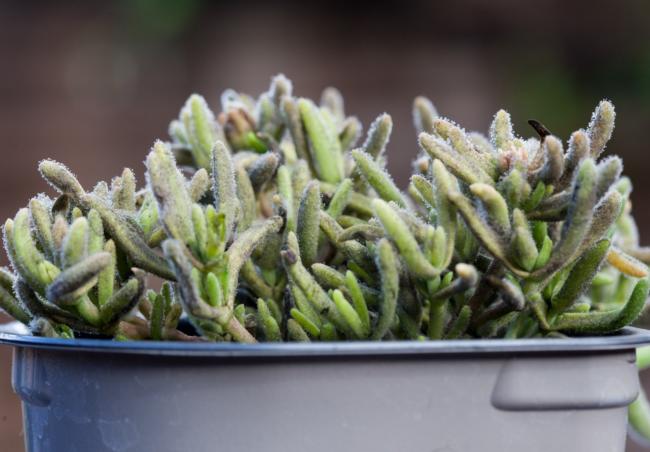
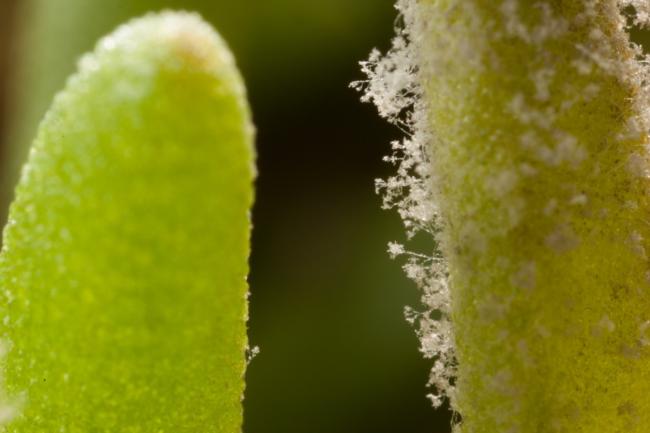
Peronospora mesembryanthemi causes downy mildew disease in its host plants. Downy mildews are fairly specific in the host plants that they attack so, in this case, as noted, the hosts of P. mesembryanthemi are found within the plant family Aizoaceae. It is likely that the pathogen survives as mycelium and/or condia (spores) in infected plant buds, plant debris, leaf tissue and shoots.
In general, downy mildews can be severe in cool or warm (but not hot), high humid climates and when a film of water is present on plant tissue. They primarily cause foliar blights and rapidly spread in young green leaf, twig and fruit tissues. They produce spores on the ends of stalks (fig. 2), and the spores can be carried by wind and rain to new infection sites on the same plant or on different plants. The pathogen can be present in soil associated with host and non-host plants. Therefore, it can spread by any means that aids in the movement of soil and/or water from infected plants to noninfected ones. The pathogen can spread by contaminated plant cuttings and transplants, in fresh leaves and sometimes within seeds.
Rhizopus stolonifer on Madagascar Periwinkle
Rhizopus stolonifer is usually a fungus you will find in your refrigerator on old vegetables or fruit, not on your greenhouse plants. It is found throughout the world on harvested fleshy organs of vegetables and fruit, and on stored bulbs, corms and rhizomes of flower crops. In a novel finding (for me), this uncommon greenhouse pathogen was found in a Monterey Bay area greenhouse causing severe dieback and even killing healthy Catharanthus roseus (Vinca rosea), commonly known as Madagascar periwinkle (fig. 3–4). It turns out that this was not new for others. A record was published in 1987 at the Institute of Horticultural Research in East Malling, England.
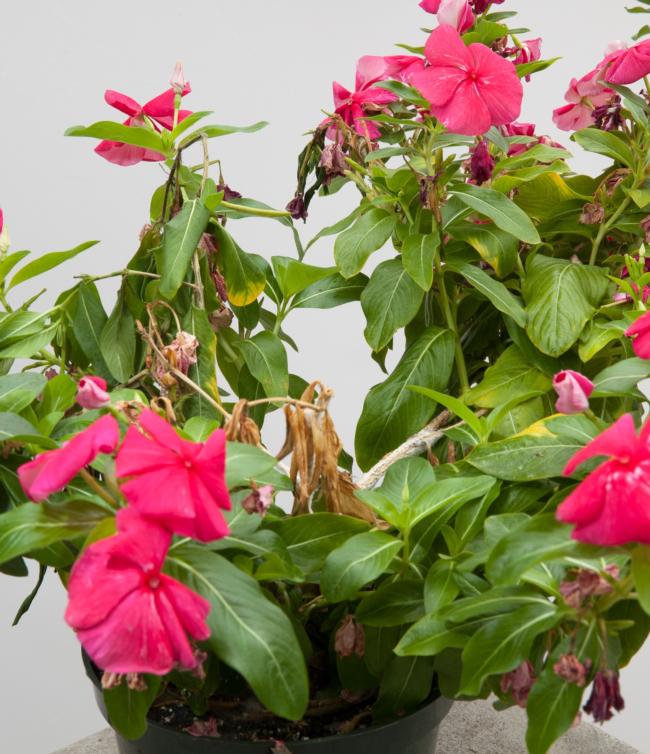
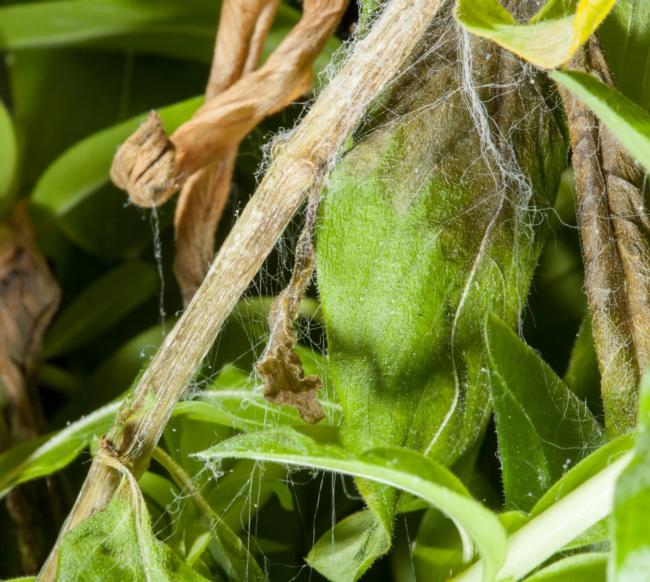
The researchers in England were researching mycoplasma-like organisms (now known as phytoplasmas) by side-grafting diseased scions to healthy plants and then enclosing the grafts in polyethene bags for 4 to 5 days to maintain high humidity. The work was periodically disrupted in 1983 to 1984 by a widespread collapse and death of plants. Turns out they determined the disease could be reproduced when they inserted agar plugs of Rhizopus stolonifer into healthy tissue.
In the case of our local nursey, the plants were being used for breeding purposes. So there was a lot of handling and pruning of flowers and stems. Wounds existed on plants where stems had apparently broken off. It is suspected that these wounds may have been the openings needed to allow this weak pathogen to enter the plant and cause disease.
Avoiding wounding is an obvious management strategy along with reducing humidity— something that might not be practical in this situation. Here is where fungicides can help. Fungicides such as the strobulurins (pyraclostrobin, azoxystrobin) could be applied after pruning and handling procedures during periods that have high relative humidity. In this way, a protective layer of fungicide would cover the wounds during periods that are favorable for infection.
Cymbidium Orchid Anthracnose Caused by Colletotrichum cymbiidicola
Previously found in San Diego and Santa Clara counties in 2014, Colletotrichum cymbiidicola was detected recently by officials in a Monterey Bay area nursery. It also has been reported in Australia, India, Japan and New Zealand. Anthracnose symptoms are expressed as dark spots or lesions in infected orchid leaves, petioles and blossoms. Initial symptoms include brown irregularly shaped sunken lesions that eventually turn dark brown with concentric brownish-black fruiting bodies. Leaf wilting may occur, often resulting in dieback and reduction in plant quality. Symptoms may be most common on orchid leaves when stressed plants have been damaged by cold and hot temperatures, sun, or wind, or have chemical or mechanical damage.
It is likely that Colletotrichum cymbidiicola has a similar life cycle to that of other Colletotrichum species and survives between crops during winter as mycelium on plant residue in soil, on infected plants and on seeds. During active growth, the pathogen produces masses of hyphae (stromata) which result in fruiting bodies (acervuli) that bear conidiophores on the plant surface. Conidia (spores) are produced at the tips of the conidiophores and disseminated by wind, rain, cultivation tools, equipment and field workers.
Of course, avoid introduction into nurseries, protect from rain, avoid splashing water from irrigations and use preventative fungicides. The following fungicides could be useful: azoxystrobin (Heritage), mancozeb (such as Dithane), copper (such as Kocide, Phyton 27), and chorothalonil (such as Daconil).
Gypsy Moths
Gypsy moths were found in Santa Cruz County this year. The first detection in early August was an Asian gypsy moth (AGM) in Santa Cruz, California and the second detection later in August was a European gypsy moth (EGM) near Nicene Marks State Park in Aptos, California. These are closely related moths whose caterpillars feed voraciously on numerous ornamentals and native plants. When they were first detected by regulatory authorities in selective insect traps, trapping was greatly intensified in a detection area around the original find. If another moth was found in these expanded detection areas, then a quarantine could be triggered that would limit the movement of nursery stock, host plants and other host materials outside the quarantine area. So far there has not been another moth found in the two established detection areas.
The Asian gypsy moth and European gypsy moth are genetically very similar, and eggs, caterpillars (larvae) and moths (adults) look very much alike too. However, the AGM has a broader host range and the female moth can fly long distances, which gives it a greater potential to spread and establish in an area where it is introduced.
Both the AGM and the EGM prefer forest habitats and can cause serious defoliation and deterioration of trees and shrubs. The EGM has more than 300 known host plants but prefers oak. The AGM has a much broader host range (over 100 botanical families), including larch, oak, poplar, alder, willow and some evergreens. In the eastern United States where the EGM has established, it can defoliate an average of 700,000 acres each year, causing millions of dollars in damage. So far AGM is not established in the United States, but if it did establish itself, the damage could be even more extensive and costly.
If you notice extensive defoliation of trees, caterpillars with blue and red dots crawling on the branches or leaves (fig. 5), or velvety egg masses, then contact the Agricultural Commissioner’s Office.
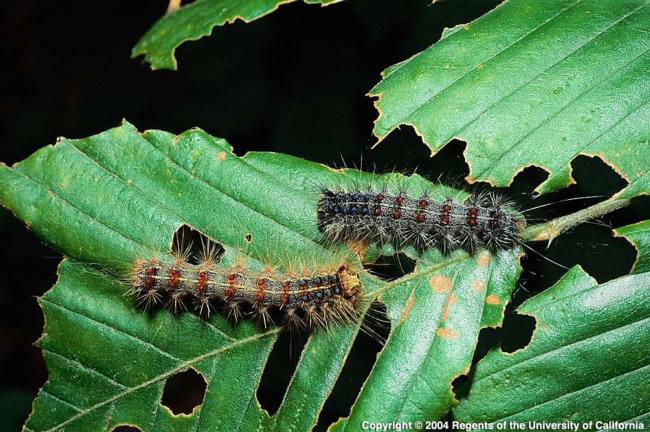
___________________________________________________________
Steven A. Tjosvold
Farm Advisor, Environmental Horticulture
UC Cooperative Extension Santa Cruz County
1432 Freedom Boulevard
Watsonville, CA 95076-2796
(831)763-8013 phone, (831) 763-8006 fax
satjosvold@ucanr.edu












